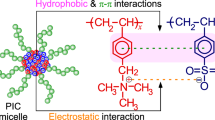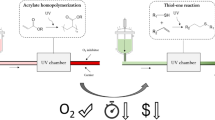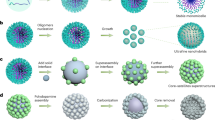Abstract
Two polystyrene (PS)-based amphiphilic diblock copolymers, PS(x)-PV(y) with x/y=3.3−7.7 and PS(x)-PA(y) with x/y=1.2−13.7 (where PS(x)-PV(y) and PS(x)-PA(y) possess poly[(ar-vinylbenzyl)trimethylammonium chloride] and poly(2-acrylamido-2-methylpropanesulfonic acid) blocks, respectively, and x and y are the degrees of polymerization), were prepared by reversible addition-fragmentation chain transfer radical polymerization to investigate the formation of reverse micelles by these copolymers in less polar organic media. The PS(x)-PV(y) samples were more dispersible in halogenated solvents, for example, chloroform and 1,2-dichloroethane (DCE), than the PS(x)-PA(y) samples because of the higher solvophobicity of the PA block. 1H NMR spectra for the PS(x)-PV(y) and PS(x)-PA(y) samples measured in CDCl3 exhibited no signals that corresponded to the PV or PA blocks in the diblock copolymers, which indicated that the PS(x)-PV(y) and PS(x)-PA(y) samples formed reverse micelles in halogenated solvents with the PV or PA blocks in the core. The structures of the reverse micelles formed from the PS(x)-PV(y) samples in DCE were investigated in detail by static and dynamic light scattering. The light scattering data indicated that PS(x)-PV(y) formed star-like micelles at x/y>6 and non-star-like micelles at x/y<6 in DCE. The morphology of the micelles formed from PS(x)-PV(y) with x/y<6 in DCE was most likely brush-like.
Similar content being viewed by others
Log in or create a free account to read this content
Gain free access to this article, as well as selected content from this journal and more on nature.com
or
References
Hashidzume, A., Morishima, Y. & Szczubiałka, K. in Handbook of Polyelectrolytes and Their Applications eds Tripathy S. K., Kumar J., Nalwa H. S.) Vol. 2, Ch. 1 1–63 (American Scientific Publishers, Stevenson Ranch, CA, USA, 2002).
McCormick, C. L., Bock, J. & Schulz, D. N. in Encyclopedia of Polymer Science and Engineering ed. Kroschwitz J. I.), Vol. 17, 730–784 (Wiley & Sons, New York, NY, USA, 1989).
Laschewsky, A. Molecular concepts, self-organisation and properties of polysoaps. Adv. Polym. Sci. 124, 1–86 (1995).
Okhapkin, I. M., Makhaeva, E. E. & Khokhlov, A. R. Water solutions of amphiphilic polymers: Nanostructure formation and possibilities for catalysis. Adv. Polym. Sci. 195, 177–210 (2006).
Glass, J. E. Hydrophilic polymers. Performance with Environmental Acceptability Advances in Chemistry Series 248 ((American Chemical Society, Washington, DC, USA, 1996).
Glass, J. E. Associative Polymers in Aqueous Solutions ACS Symposium Series 765 (American Chemical Society, Washington, DC, USA, 2000).
McCormick, C. L. Stimuli-responsive Water Soluble and Amphiphilic Polymers ACS Symposium Series 780 ((American Chemical Society, Washington, DC, 2001).
Tuzar, Z. & Kratochvíl, P. Block and graft copolymer micelles in solution. Adv. Colloid Interface Sci. 6, 201–232 (1976).
Qin, A., Tian, M., Ramireddy, C., Webber, S. E., Munk, P. & Tuzar, Z. Polystyrene- poly(methacrylic acid) block copolymer micelles. Macromolecules 27, 120–126 (1994).
Chu, B. Structure and dynamics of block copolymer colloids. Langmuir. 11, 414–421 (1995).
Förster, S., Zisenis, M., Wenz, E. & Antonietti, M. Micellization of strongly segregated block copolymers. J. Chem. Phys. 104, 9956–9970 (1996).
Moffitt, M., Khougaz, K. & Eisenberg, A. Micellization of ionic block copolymers. Acc. Chem. Res. 29, 95–102 (1996).
Förster, S. & Antonietti, M. Amphiphilic block copolymers in structure-controlled nanomaterial hybrids. Adv. Mater. (Weinheim, Ger.) 10, 195–217 (1998).
Förster, S., Abetz, V. & Müller, A. H. E. Polyelectrolyte block copolymer micelles. Adv. Polym. Sci. 166, 173–210 (2004).
Chen, D. & Jiang, M. Strategies for constructing polymeric micelles and hollow spheres in solution via specific intermolecular interactions. Acc. Chem. Res. 38, 494–502 (2005).
Choucair, A., Lavigueur, C. & Eisenberg, A. Polystyrene-b-poly(acrylic acid) vesicle size control using solution properties and hydrophilic block length. Langmuir. 20, 3894–3900 (2004).
Aoshima, S., Sugihara, S., Shibayama, M. & Kanaoka, S. Synthesis and self-association of stimuli-responsive diblock copolymers by living cationic polymerization. Macromol. Symp. 215, 151–163 (2004).
Mitsukami, Y., Hashidzume, A., Yusa, S.-i., Morishima, Y., Lowe, A. B. & McCormick, C. L. Characterization of pH-dependent micellization of polystyrene-based cationic block copolymers prepared by reversible addition-fragmentation chain transfer (RAFT) radical polymerization. Polymer. (Guildf). 47, 4333–4340 (2006).
Morishima, Y. Thermally responsive polymer vesicles. Angew. Chem. Int. Ed. 46, 1370–1372 (2007).
Chung, B., Choi, M., Ree, M., Jung, J. C., Zin, W. C. & Chang, T. Subphase pH effect on surface micelle of polystyrene-b-poly(2-vinylpyridine) diblock copolymers at the air-water interface. Macromolecules 39, 684–689 (2006).
Smith, A. E., Xu, X. & McCormick, C. L. Stimuli-responsive amphiphilic (co)polymers via RAFT polymerization. Prog. Polym. Sci. 35, 45–93 (2010).
Cheng, F., Yang, X., Peng, H., Chen, D. & Jiang, M. Well-controlled formation of polymeric micelles with a nanosized aqueous core and their applications as nanoreactors. Macromolecules 40, 8007–8014 (2007).
Zhang, L. & Eisenberg, A. Crew-cut aggregates from self-assembly of blends of polystyrene-b-poly(acrylic acid) block copolymers and homopolystyrene in solution. J. Polym. Sci., Part B: Polym. Phys. 37, 1469–1484 (1999).
Spatz, J. P., Mößmer, S. & Möller, M. Metastable reverse globular micelles and giant micellar wires from block copolymers. Angew. Chem. Int. Ed. Engl. 35, 1510–1512 (1996).
Nguyen, D., Williams, C. E. & Eisenberg, A. Block ionomer micelles in solution. 1. Characterization of ionic cores by small-angle X-ray scattering. Macromolecules 27, 5090–5093 (1994).
Zhang, L. & Eisenberg, A. Multiple morphologies of “crew-cut” aggregates of polystyrene-b-poly(acrylic acid) block copolymers. Science 268, 1728–1731 (1995).
Zhong, X. F., Varshney, S. K. & Eisenberg, A. Critical micelle lengths for ionic blocks in solutions of polystyrene-b-poly(sodium acrylate) ionomers. Macromolecules 25, 7160–7167 (1992).
Desjardins, A. & Eisenberg, A. Colloidal properties of block ionomers. 1. Characterization of reverse micelles of styrene-b-metal methacrylate diblocks by size-exclusion chromatography. Macromolecules 24, 5779–5790 (1991).
Desjardins, A., van de Ven, T. G. M. & Eisenberg, A. Colloidal properties of block ionomers. 2. Characterization of reverse micelles of styrene-b-methacrylic acid and styrene-b-metal methacrylate diblocks by dynamic light scattering. Macromolecules 25, 2412–2421 (1992).
Antonietti, M., Heinz, S., Schmidt, M. & Rosenauer, C. Determination of the micelle architecture of polystyrene/poly(4-vinylpyridine) block copolymers in dilute solution. Macromolecules 27, 3276–3281 (1994).
Thang, S. H., Chong, Y. K., Mayadunne, R. T. A., Moad, G. & Rizzardo, E. A novel synthesis of functional dithioesters, dithiocarbamates, xanthates and trithiocarbonates. Tetrahedron Lett. 40, 2435–2438 (1999).
Hashidzume, A., Kawaguchi, A., Tagawa, A., Hyoda, K. & Sato, T. Synthesis and structural analysis of self-associating amphiphilic statistical copolymers in aqueous media. Macromolecules 39, 1135–1143 (2006).
Kanao, M., Matsuda, Y. & Sato, T. Characterization of polymer solutions containing a small amount of aggregates by static and dynamic light scattering. Macromolecules 36, 2093–2102 (2003).
Kawata, T., Hashidzume, A. & Sato, T. Micellar structure of amphiphilic statistical copolymers bearing dodecyl hydrophobes in aqueous media. Macromolecules 40, 1174–1180 (2007).
Utiyama, H., Takenaka, K., Mizumori, M. & Fukuda, M. Light-scattering studies of a polystyrene-poly(methyl methacrylate) two-block copolymer in dilute solutions. Macromolecules 7, 28–34 (1974).
Tanaka, T., Kotaka, T. & Inagaki, H. Intermolecular correlation in light scattering from dilute solutions of block copolymers. Macromolecules 7, 311–319 (1974).
Israelachvili, J. N. In Intermolecular and surface forces 2nd ed. Ch. 16 (Academic Press, London, 1992).
Outer, P., Carr, C. I. & Zimm, B. H. Light scattering investigation of the structure of polystyrene. J. Chem. Phys. 18, 830–839 (1950).
Sato, T. & Matsuda, Y. Macromolecular assemblies in solution: Characterization by light scattering. Polym. J. (Tokyo, Jpn.) 41, 241–251 (2009).
Zhang, W., Zhou, X., Li, H., Fang, Y. & Zhang, G. Conformational transition of tethered poly(N-isopropylacrylamide) chains in coronas of micelles and vesicles. Macromolecules 38, 909–914 (2005).
Koyama, R. & Sato, T. Thermodynamic properties of toluene solutions of low molecular weight polystyrenes over wide ranges of concentration. Macromolecules 35, 2235–2242 (2002).
Acknowledgements
This work was partially supported by Grant-in-Aid for Scientific Research No. 23350055 and 23550137 from the Japan Society for the Promotion of Science.
Author information
Authors and Affiliations
Corresponding author
Additional information
Supplementary Information accompanies the paper on Polymer Journal website
Supplementary information
Rights and permissions
About this article
Cite this article
Arai, T., Masaoka, M., Michitaka, T. et al. Aggregation behavior of polystyrene-based amphiphilic diblock copolymers in organic media. Polym J 46, 189–194 (2014). https://doi.org/10.1038/pj.2013.80
Received:
Revised:
Accepted:
Published:
Issue date:
DOI: https://doi.org/10.1038/pj.2013.80



